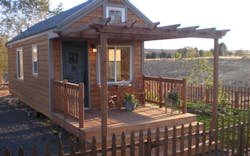Wealthy communities have microgrids. Now tiny house communities want them, too
The fast-growing tiny house movement wants its own microgrids and is seeking to create standards for microgrids in tiny home communities.
Such communities won’t look like higher end microgrid neighborhoods that, in some cases, market homes for upward of $1 million. By contrast, a tiny house costs about $150,000, generally lacks upscale amenities and is sized at about 6oo square feet.
“Tiny houses are like little darling cottages on wheels. They’re basically a combination of a house and an RV,” said Janet Thome, founder and president of Tiny House Alliance USA.
The cottages appeal to a broad range of people. Some communities, like Portland, Oregon’s solar-equipped Dignity Village, host residents who were formerly homeless. Tiny homes are also appealing to people who are just entering the home market, as well as those who seek efficiency and a simpler way of life. With housing prices high, tiny homes are increasing in popularity, said Thome.
Microgrids for resource sharing
But, like other homeowners today, tiny home enthusiasts seek resilience, sustainability, lower cost energy and energy sharing among residents.
Connecting to infrastructure is expensive, and sharing those connections can cut costs, Thome said. “Nobody can afford to do things by themselves when a new septic system in Santa Cruz costs $50,000,” she said. Forming tiny house communities will not only lower housing costs, but will lower utility and infrastructure costs if residents band together and share resources such as microgrids, she added.
Energy resilience and sustainability are especially important to the tiny home enthusiasts. “Resilience is absolutely important. Our stakeholders include experts in net-zero energy construction and off-grid. We have been talking about resilience,” said Thome.
The tiny home market share is expected to increase by $3.57 billion between 2021 and 2026, and the market is expected to grow at a compound annual growth rate of 4.45%.
Tiny homes, big problems
Despite the popularity of tiny homes, the community faces challenges, said Thome. Often they are defined not as homes, but as vehicles, much like RVs.
And cities often categorize the houses as temporary and refuse to treat them like permanent residences for zoning and planning purposes. Since each city treats them differently, builders and buyers are often confused about where and how to locate them, she said. That’s why the industry needs its own standards.
Thome aims to create new standards specifically for tiny houses through the standards publisher ASTM International.
“We want our tiny houses on wheels to be seen as permanent. We want to standardize our industry,” Thome said.
ASTM International’s committee on performance of buildings recently approved a new subcommittee on tiny houses that aims to develop standards. Microgrid standards are among those that Thome and other stakeholders want included.
Initially, the subcommittee will work on developing a uniform construction standard for a tiny house on wheels and create a new classification of housing that’s separate from RVs, she said. Microgrid standards will be part of that work. This effort could take nine to 18 months, she said.
Good fit for efficiency geeks
Microgrids are seen as a good fit for the tiny home culture, which focuses on efficiency, sustainability and resource sharing.
“I hang out with a lot of efficiency geeks, and we always talk about microgrids. They seem like a natural fit for tiny houses,” said Jay Shafer, owner and designer for Tumbleweed Tiny House, which provides tiny homes whose materials are certified to be green.
Numerous individual tiny homes have solar, and a few are off-grid units powered by microgrids. For example, one tiny solar home includes a Humless power system with 6.5 kW of battery storage and eight 250-watt solar panels.
Standards for microgrids
When the ASTM subcommittee begins its work, it will discover that the microgrid industry has been developing its own standards. For example, in 2018, the Institute for Electrical and Electronics Engineers approved the second of two companion standards for advanced microgrid controllers. This creates an industry standard that specifies exactly what’s needed to test microgrid controllers.
And the US Army is working on setting standards for using the most energy-efficient systems available – including renewables and battery storage – to minimize base fuel demands.
Meanwhile, the solar and storage industries have their own standards that address issues such as fire risks and fumes.
As the tiny house industry continues to grow so, too, will the renewable energy and microgrid systems that are included in the homes. Thome is working to ensure that the standards needed to outfit these homes and communities with microgrids will be in place soon, making it easier to create low-cost, sustainable and resilient communities that serve the needs of many different types of people, from the poor to the homeless to the efficiency geeks.
About the Author
Lisa Cohn
Contributing Editor
I focus on the West Coast and Midwest. Email me at [email protected]
I’ve been writing about energy for more than 20 years, and my stories have appeared in EnergyBiz, SNL Financial, Mother Earth News, Natural Home Magazine, Horizon Air Magazine, Oregon Business, Open Spaces, the Portland Tribune, The Oregonian, Renewable Energy World, Windpower Monthly and other publications. I’m also a former stringer for the Platts/McGraw-Hill energy publications. I began my career covering energy and environment for The Cape Cod Times, where Elisa Wood also was a reporter. I’ve received numerous writing awards from national, regional and local organizations, including Pacific Northwest Writers Association, Willamette Writers, Associated Oregon Industries, and the Voice of Youth Advocates. I first became interested in energy as a student at Wesleyan University, Middletown, Connecticut, where I helped design and build a solar house.
Twitter: @LisaECohn
Linkedin: LisaEllenCohn
Facebook: Energy Efficiency Markets

